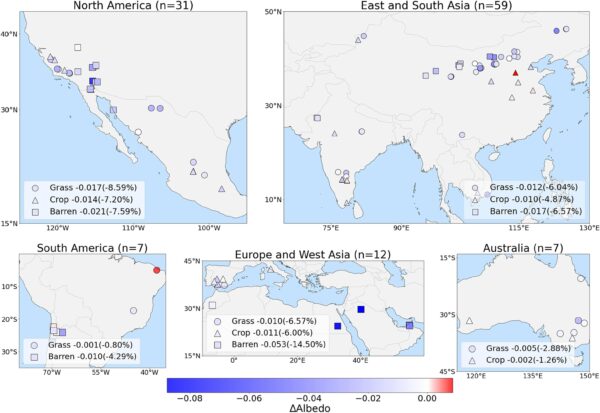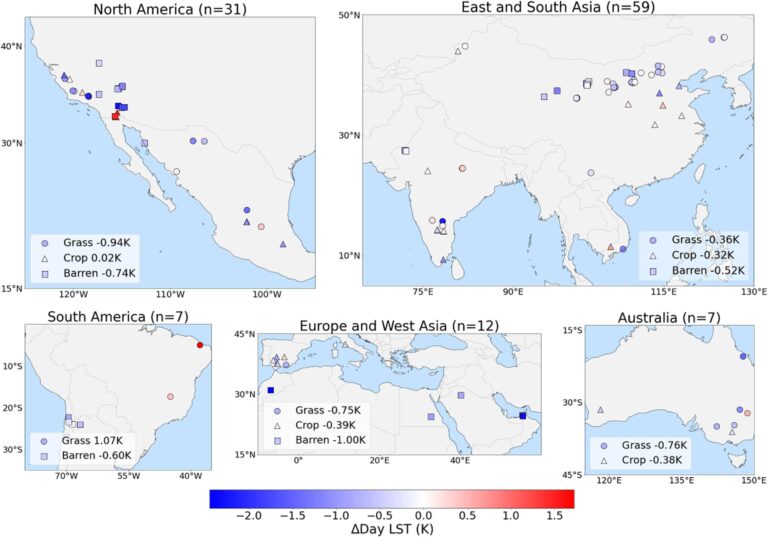Using remote sensing, researchers from China and the United States have quantified the effects of solar farms (SFs) on albedo, vegetation, and land surface temperature (LST). Namely, they have used data from the MODIS instrument onboard NASA’s Terra and Aqua satellites to analyze data regarding 116 solar farms worldwide.
“Satellite data with high spatial resolution and global coverage enables the detection of changes in surface properties at fine scales,” they explained. “We use long-term remote sensing observations from MODIS, which have good temporal coverage and moderate spatial resolutions.”
While some SFs analyzed in the study were photovoltaic (PV) and some were concentrating solar power (CSP) sites, all had a minimum occupying area of 400 ha. The scientific group also analyzed non-SF buffer areas. They were generated as ring-shaped areas with a width of 1 km surrounding the SF and 1 km away from the boundary.
The research has examined three MODIS measurements – LST, albedo, vegetation, and enhanced vegetation index (EVI). These values were quantified during a 5-year window, as the first measurements were from two years before the year of construction and the last from after two years as well. To rule out any natural climate variability, the change in the buffer area was deducted from the change measured in the SF site.
“Globally, there was a significant decrease in albedo of -0.016 for most SF samples,” the research found. “Regionally, SF in North America (NA) experienced a larger albedo decline (-0.014 to -0.021) than those in East and South Asia (ESA) (-0.010 to -0.017).”

As for the vegetation, the overall EVI index decreased by -0.015, an 8.2% drop. That also exhibited regional variations – as all sites in North America showed a decrease of 0.023 in the EVI, while in East and South Asia, approximately a third of the SF showed an increase.
As for the LST, the researchers found an average cooling effect of -0.49 K during the daytime and -0.21 K during the nighttime. Additionally, 94 of the 116 states experienced land cooling in the daytime, while only 82 experienced it in the nighttime.
“Since there are different types of solar energy technologies, PV and CSP, we searched for pairs of PV and CSP SFs with the same land cover and in the same latitudinal band to compare their impacts,” the researchers added. “On barren land, PV had overall stronger impacts than CSP, except for a larger daytime cooling with CSP. In contrast, on cropland, PV had weaker impacts on albedo and daytime LST than CSP but greater impacts on EVI and night LST.”
The results of their analysis were presented in “A global assessment of the effects of solar farms on albedo, vegetation, and land surface temperature using remote sensing,” published on Solar Energy. It was written by academics from China’s Beijing Normal University, the Southern University of Science and Technology, and the US’s California Institute of Technology.
This content is protected by copyright and may not be reused. If you want to cooperate with us and would like to reuse some of our content, please contact: editors@pv-magazine.com.








By submitting this form you agree to pv magazine using your data for the purposes of publishing your comment.
Your personal data will only be disclosed or otherwise transmitted to third parties for the purposes of spam filtering or if this is necessary for technical maintenance of the website. Any other transfer to third parties will not take place unless this is justified on the basis of applicable data protection regulations or if pv magazine is legally obliged to do so.
You may revoke this consent at any time with effect for the future, in which case your personal data will be deleted immediately. Otherwise, your data will be deleted if pv magazine has processed your request or the purpose of data storage is fulfilled.
Further information on data privacy can be found in our Data Protection Policy.